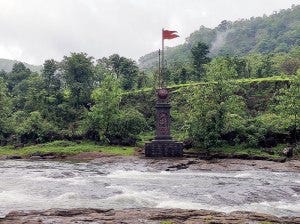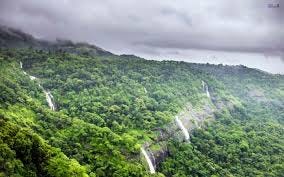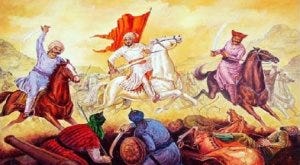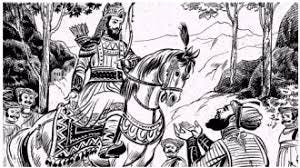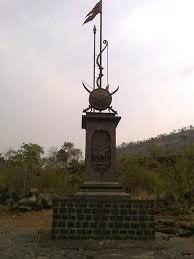Around 4 km from Khemabari village in the Khalapur taluk of Raigad district, on the Khapoli-Poli road, is located a small tri junction at Chavani. The Amba river here originates from the foot of a small cone, near to Kurnawade village in the Maval Taluka. The river passes by Umarkhandi along the Garmal valley, and merging with the Nagothane creek, before it merges into the sea.
Umberkhind is one of the many ghats in the Nain-Maval area, located right below Kurnawade Ghat. During the first Anglo Maratha War in 1781, the Peshwa chieftain Haripant Phadke, guarded this area to prevent the British from approaching Ghatmatha via Kuranwade Ghat, instead of Bor Ghat. One of the narrowest passes, in the Western Ghats, separating Lohghad from Visaghad running parallel to Mumbai-Pune rail route, it is a popular trekking route in the Sahyadris.
This pass would however be remembered for a historic battle fought here on February 3, 1661, when Chattrapati Shivaji Maharaj defeated Kartalab Khan, the right hand man of Shaishta Khan, one of the most decisive victories ever, that further consolidated his position and strengthened the Marathas.
Kartalab Khan was Shaishta Khan’s right hand man, whom Aurangzeb specifically sent to crush Shivaji in 1660. Setting up base at Pune, he captured the Chakan fort by June 1660. And by 1661 Shaista Khan, sent him to capture the forts of Kalyan, Bhiwandi, Panvel, Chul and Nagothane in the North of Konkan. Along with Kartalab were the Rajput chieftains Chaturbuj Chauhan, Amarsingh Chandravat, Mitrasen and his brother Sarjerao Gadhe.
Kartalab Khan started from Pune on February 3, 1661, leading an army of 20,000 troops, which while was adept at open plains warfare, had no experience dealing with guerilla warfare which the Marathas used. His experience was primarily in the open plains of North India, that too against armies made up mostly of mercenaries. Here he was dealing with the Marathas in absolutely hill territory, who were ideologically driven by the Haindavi Swarajya dream.
Kartalab made his way via Chinchwad, Talegaon, Vadagon, and instead of taking a turn towards Lohagad fort, that was right on the border between the Sahayadris and Konkan, he took the steeper descent from Ghathmatha towards Umberkhind, a very narrow route. His original plan was to travel via the Bor Ghat( now the Khandala Ghat), which actually was much more wider.Fact is had Kartalab, taken the route via Bor Ghat, it would have been a much more tougher battle for Shivaji, as that was quite wide and open.
One aspect of Shivaji’s campaigns not that well known, is that he had an awesome intelligence network, which is how we actually managed to win so kany battles. He had spies, who would track every moment of the enemy, keeping him always one step ahead.
It was not just the intelligence gathering, Shivaji also used the tactics of disinformation really well to fool the enemy. And he did so here, feeding Kartalab Khan information through his spies, that Shivaji was at Pen, in Raigad district, throwing him off track. The disinformation strategy worked, it made Kartalab Khan change his original plan of travelling via Bor Ghat, to Umberkhind Pass, assuming that Shivaj was at Pen, when in fact he was waiting there. A trap had been set and Kartalab walked straight into it.
To put it into perspective Umbarkhind is 2200 feet above sea level, you would need a descent of 300 feet to Tugaranya, which was surrounded on all sides by forest and hills. And Kartalab Khan was actually planning to fight Shivaji at this place. Shivaji knew the Sahayadris and Western Ghats like the palm of his hand, he grew up there. What Kartalab Khan tried was equivalent to bearding the lion in his own den, that too a rather ferocious lion which had the fight in him.
The trap was the pass of Umberkhind where Shivaji and his 1000 strong men were hiding in wait, equipped with arrows, boulders, rifles. The thick dense forests, made it easy for the Marathas to camouflage themselves, from the Mughal soldiers. Mounted on a horse,holding a bow in one hand, with a spear in another, sword dangling from his waist, Shivaji Maharaj, waited for Kartalab and his army to descend the pass. The Marathas slowly surrounded the Mughal Army without them even being aware of it. It was a perfect trap, and by the time they reached the base, they were surrounded from all sides.
The Marathas began their attack by rolling boulders on to the hapless Mughal Army, And they were surrounded on all sides, even worse they could not even see them, due to the thick forest cover. It was a rout for the Mughal army, as the Marathas pounced on them, and within 2-3 hours, the battle was well and over.
Kartalab Khan had to send a message to Shivaji Maharaj, that he was willing to surrender and leave the place for good. Maharaj accepted the proposal, as Kartalab Khan, Mitrasen laid down their arms in front of him, all the other Maratha sardars fighting in Umberkhind, were asked to cease fire, as the Mughals made a retreat, leaving the entire armory to Shivaji, which gave the Marathas more firepower.
Not to mention large amounts of gold and jewelery. And some of the Mughal soldiers too switch sides to Shivaji. Netaji Palkar was put in charge of the Konkan, to thwart further attacks by the Mughals.
Once again a 1000 strong Maratha Army under Shivaji Maharaj had defeated a much larger Mughal force of around 20,000, just using smart strategy and tactics. The victory at Umberkhind is considered one of the great victories in Shivaji Maharaj’s career, and is commemorated every year on February 2 since 2001.
Shiva Mitra, a Lonavala based organization has erected a victory memorial here that was inaugurated in 2007 by Babasaheb Purandhare and Udayan Raje Bhonsle. The memorial is around 12.5 m high, bearing a statue of Shivaji Maharaj in the front. A brief history of Umberkhind battle is engraved on the right side of the memorial.



